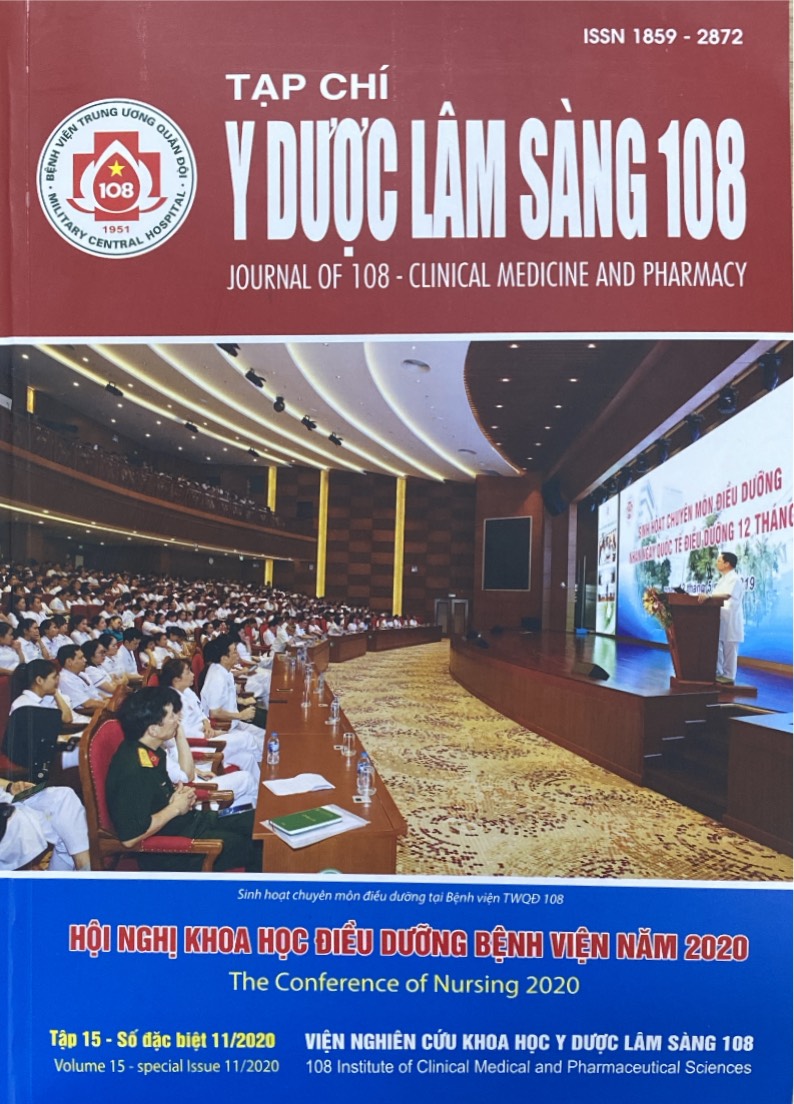Results of patient care after liver resection for hepatocellular carcinoma
Main Article Content
Keywords
Abstract
Objective: To evaluate of patient care results after liver resection for hepatocellular carcinoma (HCC) at the Department of Hepatobiliary and Pancreatic Surgery in 108 Military Central Hospital. Subject and method: A descriptive cross-sectional study on 115 HCC patients after hepatectomy at the Department of Hepatobiliary and Pancreatic Surgery, 108 Military Central Hospital from October 2019 to June 2020. Result: The vital signs of the patients in our study were acceptable, post-operative fever on the second and third day were low (4.34%). The rate of redness at the insicion site on the first day after surgery was 10.43%, the rate of stagnant wound fluid point on the second post-operative day was 6.09%; the rate of dry incision when discharge was 100%. 82.61% of patients had daily dressing changes. The timing of drain removal was mainly after 72 hours, accounted for 70.21%. All patients in our study discharged from hospital without drain carrying. The rate of normal post-operative oral feeding on the fourth and fifth day were 83.48% and 94.78%, respectively. 10.43% of patients had superficial wound infections. Conclusion: The study shows that patient care after liver resection for HCC is very important; to detect complications, help patients with pain relief, fast recovery, and contribute to the success of surgery.
Article Details
References
2. Bùi Thị Bích Ngà (2011) Thực trạng công tác chăm sóc của điều dưỡng qua nhận xét của người bệnh điều trị nội trú tại Bệnh viện Y học Cổ truyền Trung ương năm 2011. Luận văn thạc sĩ quản lý bệnh viện, Trường Đại học Y tế Công cộng, Hà Nội.
3. Vũ Văn Quang (2019) Nghiên cứu ứng dụng kỹ thuật kiểm soát cuống Glisson theo Takasaki trong cắt gan điều trị ung thư biểu mô tế bào gan tại Bệnh viện Trung ương Quân đội 108. Luận án Tiến sĩ Y học, Viện NCKH Y Dược lâm sàng 108.
4. Nguyễn Thị Thùy Trâm (2014) Thực trạng hoạt động chăm sóc người bệnh của điều dưỡng viên và một số yếu tố liên quan tại Bệnh viện Nguyễn Đình Chiểu tỉnh Bến Tre năm 2014. Luận văn thạc sĩ, Trường DDại học Y tế Công cộng.
5. Ashok T and Wei-Chen L (2013) Critical care issues after major hepatic surgery. Chapter 4: 83-103.
6. Cheng-Yuan H, Gar-Yang C, Kuang-Liang K, Che-Chuan L, Wing-Yiu L, Chew-Wun W (2003) Factors for prolonged length of stay after elective hepatectomy for hepatocellular carcinoma. The surgeon's role in the managed care era. Hepatogastroenterology 50(51): 798-804.
7. GLOBOCAL IARC (2012) Cancer fact sheet: Liver caner incidence and mortality wordwide.
8. Lindsay JW, Karen R O’Bosky, Jukes PN, Maheswari S (2012) Postoperative management after hepatic resection. J Gastrointest Oncol 3: 41-47.
9. Richter B, Schmandra TC, Golling M, Bechstein WO (2006) Nutritional support after open liver resection: A systematic review. Dig Surg 23: 139-145.
10. Yufeng Liu et al (2018) Evaluation of intravenous parecoxib infusion pump of patient-controlled analgesia compared to fentanyl for postoperative pain management in laparoscopic liver resection. Med Sci Monit 24: 8224-8231.
 ISSN: 1859 - 2872
ISSN: 1859 - 2872
